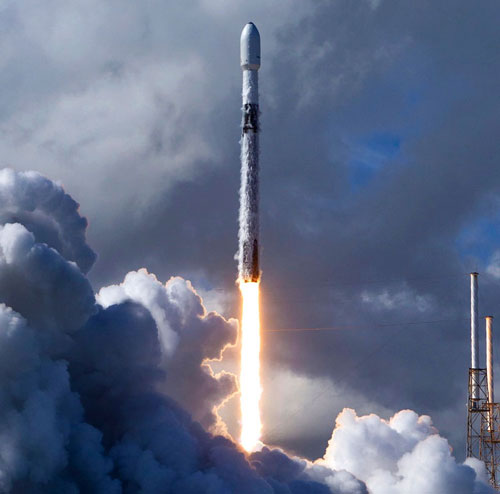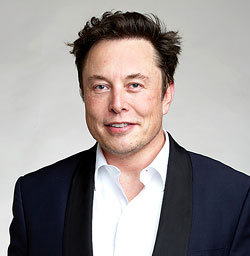INDIAN ARMED FORCES CHIEFS ON
OUR RELENTLESS AND FOCUSED PUBLISHING EFFORTS

SP Guide Publications puts forth a well compiled articulation of issues, pursuits and accomplishments of the Indian Army, over the years

I am confident that SP Guide Publications would continue to inform, inspire and influence.

My compliments to SP Guide Publications for informative and credible reportage on contemporary aerospace issues over the past six decades.
SpaceX’s 25th launch this year; strengthens commercial spaceflight
Last month, SpaceX also received certification from NASA for human spaceflight

On December 13, Falcon 9 launched the SXM-7 mission from Space Launch Complex 40 (SLC-40) at Cape Canaveral Space Station, Florida, marking SpaceX’s 25th mission just in 2020.
SpaceX noted that this mission marked the seventh flight of this Falcon 9 first stage rocket booster, which previously supported launch of Crew Dragon’s first flight to the International Space Station (Demo-1), launch of the RADARSAT Constellation Mission, and four Starlink missions in 2020. Following stage separation, SpaceX landed Falcon 9’s first stage on the “Just Read the Instructions” droneship, which was located in the Atlantic Ocean.
Despite the pandemic woes, SpaceX seems to be on an upward journey this year adding new feathers to its cap.
On December 9, Starship serial number 8 (SN8) lifted off from Cameron County launch pad and successfully ascended, transitioned propellant, and performed its landing flip maneuver with precise flap control to reach its landing point. “Low pressure in the fuel header tank during the landing burn led to high touchdown velocity resulting in a hard (and exciting!) landing,” stated SpaceX. While many reported the hard landing as a crash, SpaceX nevertheless hailed it as a success.
“Fuel header tank pressure was low during landing burn, causing touchdown velocity to be high & RUD, but we got all the data we needed! Congrats SpaceX team hell yeah!! Successful ascent, switch over to header tanks & precise flap control to landing point. Mars, here we come,” tweeted Elon Musk, SpaceX CEO, calling this as the gateway to Mars.
While on December 6, 2020, SpaceX’s upgraded cargo Dragon spacecraft lifted-off on its way to the International Space Station (ISS) after launching atop a Falcon 9 rocket from Launch Complex 39A at NASA’s Kennedy Space Center in Florida. This was the first launch for SpaceX under NASA’s second Commercial Resupply Services contract, CRS-21 which delivered supplies, equipment, and materials to directly support dozens of the more than 250 science and research investigations that will occur aboard the orbiting laboratory during Expeditions 64 and 65.
On December 9, Starship serial number 8 (SN8) lifted off from Cameron County launch pad but high touchdown velocity resulted in a hard (and exciting!) landing. While many reported the hard landing as a crash, SpaceX nevertheless hailed it as a success.
“Fuel header tank pressure was low during landing burn, causing touchdown velocity to be high & RUD, but we got all the data we needed! Congrats SpaceX team hell yeah!! Successful ascent, switch over to header tanks & precise flap control to landing point. Mars, here we come,” tweeted Elon Musk, SpaceX CEO, calling this as the gateway to Mars.
Included in this delivery was the Nanoracks Bishop Airlock, the first commercially owned and operated airlock that, once installed, will provide a variety of capabilities to the space station, such as payload hosting, robotics testing, and satellite deployment, stated NASA. It is also said that it will serve as an outside toolbox for crew members conducting spacewalks.
Dragon was scheduled to arrive at the space station on December 7, 2020. Cargo Dragon’s arrival at the space station marked the first time two Dragon spacecraft were docked to the orbiting laboratory at the same time. The Crew Dragon spacecraft, named Resilience that brought the Crew-1 astronauts has been docked since its arrival on November 16, 2020.
The Cargo Dragon spacecraft will remain attached to the space station for about one month, after which it will return to Earth with 5,200 pounds of research and return cargo, splashing down in the Atlantic Ocean.
The Falcon 9 rocket’s first stage had successfully landed on the “Of Course I Still Love You” droneship in the Atlantic Ocean on December 6, 2020, marking the 100th successful landing of a Falcon 9 first stage, and the 35th landing on a droneship. This was the fourth flight for this particular first stage – one of those being the agency’s SpaceX Demo-2 mission that carried NASA astronauts Bob Behnken and Doug Hurley to the ISS.
NASA CERTIFIES SPACEX FOR HUMAN SPACEFLIGHT
Last month on November 10, 2020, SpaceX issued an update notifying that NASA (National Aeronautics and Space Administration) has certified SpaceX for human spaceflight. “Today, NASA announced it has certified SpaceX’s Falcon 9 and Crew Dragon human spaceflight system for crew missions to and from the International Space Station – the first commercial system in history to achieve such designation. Not since the certification of the space shuttle nearly 40 years ago has NASA certified a spacecraft, rocket, and ground support systems for regular flights with astronauts,” the release stated.
Launched atop Falcon 9 on May 30, 2020, Dragon’s second demonstration flight test to and from the space station restored human spaceflight to the United States for the first time in almost a decade.
NASA announced it has certified SpaceX’s Falcon 9 and Crew Dragon human spaceflight system for crew missions to and from the International Space Station – the first commercial system in history to achieve such designation
That flight was the culmination of years of development, testing, and training-all throughout safety remained SpaceX’s top priority, noted SpaceX further adding “SpaceX put every component of every system through its paces, including two flight tests to and from the International Space Station, demonstrations of Dragon’s escape system both on the launch pad and in-flight, over 700 tests of the spacecraft’s SuperDraco engines, more than 500 joint soft-capture docking tests to validate the performance of Dragon’s docking system design, about 8,000,000 hours of hardware in the loop software testing, and nearly 100 tests and flights of Dragon’s parachutes to ensure a safe landing back on Earth-in addition to all of the knowledge gained from twenty previous successful cargo resupply missions to the space station and over forty Falcon 9 block 5 launches.”
It was marked as an historic moment in May as NASA astronauts launched from American soil for the first time in a commercially built and operated American crew spacecraft on its way to the ISS. The SpaceX Crew Dragon spacecraft carrying NASA astronauts Robert Behnken and Douglas Hurley lifted off on the company’s Falcon 9 rocket from Launch Complex 39A at NASA’s Kennedy Space Center in Florida. The same launch pad was used for the Apollo 11 Moon landing mission.
“Today a new era in human spaceflight begins as we once again launched American astronauts on American rockets from American soil on their way to the International Space Station (ISS), our national lab orbiting Earth,” NASA Administrator Jim Bridenstine had said that time. “I thank and congratulate Bob Behnken, Doug Hurley, and the SpaceX and NASA teams for this significant achievement for the United States. The launch of this commercial space system designed for humans is a phenomenal demonstration of American excellence and is an important step on our path to expand human exploration to the Moon and Mars.”
The Demo-2 mission was deemed as the final major test before NASA’s Commercial Crew Program that will certify Crew Dragon for operational, long-duration missions to the space station. As SpaceX’s final flight test, it will validate all aspects of its crew transportation system, including the Crew Dragon spacecraft, spacesuits, Falcon 9 launch vehicle, launch pad 39A, and operations capabilities.This was SpaceX’s second spaceflight test of its Crew Dragon and its first test with astronauts aboard, which will pave the way for its certification for regular crew flights to the station as part of Commercial Crew Program. This programme is a partnership to develop and fly human space transportation systems.
An international crew of astronauts was en route to the ISS on November 14, 2020 following a successful launch on the first NASA-certified commercial human spacecraft system in history. NASA’s SpaceX Crew-1 mission lifted off from Launch Complex 39A at the agency’s Kennedy Space Center in Florida.The SpaceX Crew Dragon Resilience successfully docked to the ISS on November 16, 2020, transporting the NASA astronauts.
The SpaceX Falcon 9 rocket propelled the Crew Dragon spacecraft, named Resilience, with NASA astronauts Michael Hopkins, Victor Glover, and Shannon Walker, along with Soichi Noguchi of the Japan Aerospace Exploration Agency (JAXA), into orbit to begin a six-month science mission aboard the space station.
“NASA is delivering on its commitment to the American people and our international partners to provide safe, reliable, and cost-effective missions to the International Space Station using American private industry. This is an important mission for NASA, SpaceX and our partners at JAXA, and we look forward to watching this crew arrive at station to carry on our partnership for all of humanity,” said NASA Administrator Jim Bridenstine.
The Crew-1 mission is the first of six crewed missions NASA and SpaceX will fly as part of the agency’s Commercial Crew Program.
“I could not be more proud of the work we’ve done here today,” said Gwynne Shotwell, President and Chief Operating Officer of SpaceX. “Falcon 9 looked great, Dragon was dropped off into a beautiful orbit about 12 minutes into the mission, and we’ll get more data as we go.”
NASA stated that this mission has several firsts, including:
- The first flight of the NASA-certified commercial system designed for crew transportation, which moves the system from development into regular flights;
- The first international crew of four to launch on an American commercial spacecraft;
- The first time the space station’s long duration expedition crew size will increase from six to seven crew members, which will add to the crew time available for research; and
- The first time the Federal Aviation Administration has licensed a human orbital spaceflight launch.
Human spaceflight is SpaceX’s core mission, and “we take seriously the responsibility that NASA has entrusted in us to safely carry astronauts to and from the International Space Station. We are humbled to help NASA usher in a new era of space exploration,” stated SpaceX.
With all these constant highlights and many more to come, SpaceX has certainly opened a wide scope of possibilities and a doorway to commercial flight.






